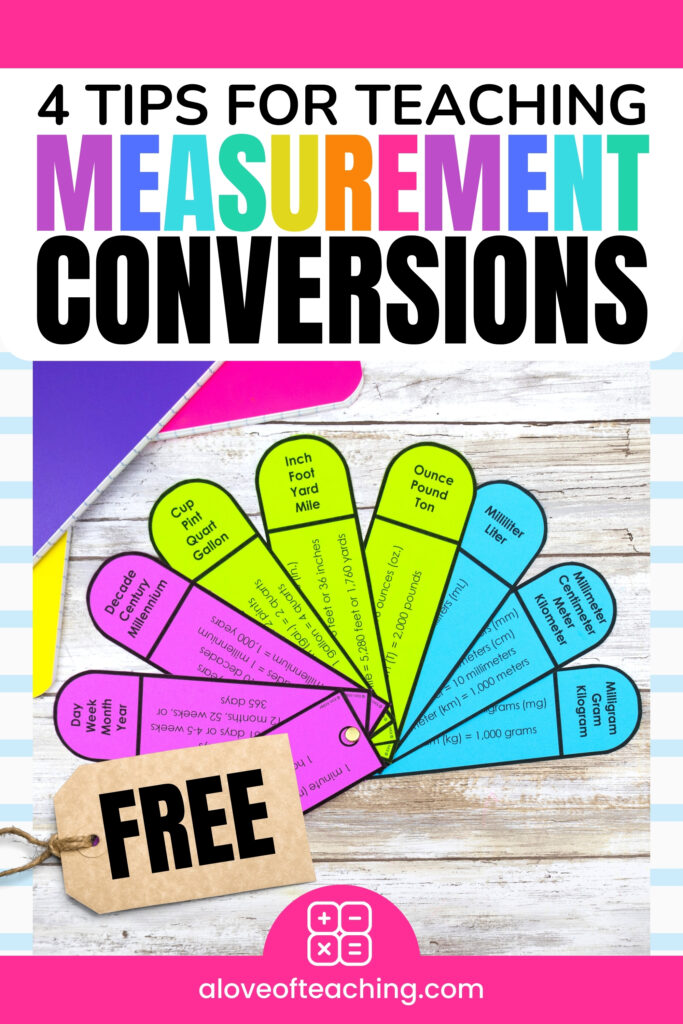4 Tips for Teaching Measurement Conversions
Teaching measurement is not for the faint of heart. Measurement can be a tricky topic for students, just as it can be extremely tricky to teach. Measurement conversions are pretty straightforward and, let’s face it – boring. Converting measurements can be challenging because it taps into other math skills like operations or number sense. I think of it as the equivalent of teaching multiplication fact fluency. With numerous units to juggle—cups, ounces, millimeters, liters, centimeters, and more—it’s no surprise that students often find themselves lost in this sea of numbers. It’s like a complex puzzle that makes their eyes glaze over when tackling the fundamentals of measurement. However, with these four tips for teaching measurement conversions, your students will have a foundational understanding of this essential skill.

Tip #1 Measurement Sort
Providing hands-on learning is a fantastic way to teach measurement. A measurement sort activity can educate students on the differences between units and their relevance to everyday things.
You can use everyday household or classroom objects for your measurement sort. Make sure to choose objects with differing weights and measurement units. Label cards with the type of units represented by each object and place the cards in random places around the room. Designate an area in the center of the room for all your chosen objects. Allow students to select objects and place them underneath the card with the correct unit in which the object would be measured.
Tip #2 Measurement Scavenger Hunt
Another fun and interactive way of teaching measurement conversions is by having a scavenger hunt. And the best part? It is basically no prep! Distribute some clipboards to your students and give them a basic guide to the scavenger hunt. For example, have them find an object in the classroom that can be measured in feet, another object in pounds, and another object in centimeters. Have them list the object and measure the object. Once finished, have students convert the measurement into the smallest unit.
Tip #3 Use a Measurement Reference
Converting measurements is a skill that students will actually use in the real world. However, knowing the conversions off the top of your head can be challenging in upper elementary. Luckily, providing students with a quick reference tool is key to solving conversions quickly.
There are so many reference tools out there, but I personally love the Measurement Conversion Chart Fan! Students can easily tuck them away in their desks or binders and pull them out when they need a fast reference. Luckily, you can snag the freebie below!



There are nine fans included with customary, metric, and time conversions. Specifically, there is a reference for customary weight, metric length, calendar time, and more! Each page can be printed on different colored paper and then attached together using a brad. This way, students can have the measurement conversions in their back pocket. Students love having a measurement reference near them. It boosts their confidence and takes away the confusion of converting measurements.

Tip #4 World Record Conversion
What student doesn’t love thumbing through amazing world records?! Let students choose a world record based on their interests. Have them take the unit of measurement and convert the unit. For example, if the greatest distance walked in twenty-four hours is 142 miles, have students convert the miles to kilometers. Using world records is an engaging way of teaching measurement conversions because students get to choose a record that interests them!
There are so many interactive ways to help your students practice converting measurements. Showing students how measurement is used in their daily lives can stress the importance of why it is such an essential skill. Ultimately, teaching measurement conversions take time and lots of patience. However, the more practice students have with the skill, the more successful they will be.
Ready to take your classroom to the next level? Sign up for our exclusive email list for tips, resources, and freebies to support your teaching journey. Don’t miss the opportunity to join our community of dedicated educators transforming their classrooms one resource at a time. Subscribe now and stay ahead of the game!
Grab the Conversion Chart Fan!
Save this post!
Save this resource to your favorite measurement Pinterest board! You will be able to come back to it when you are ready to dive into converting measurements with your students.



